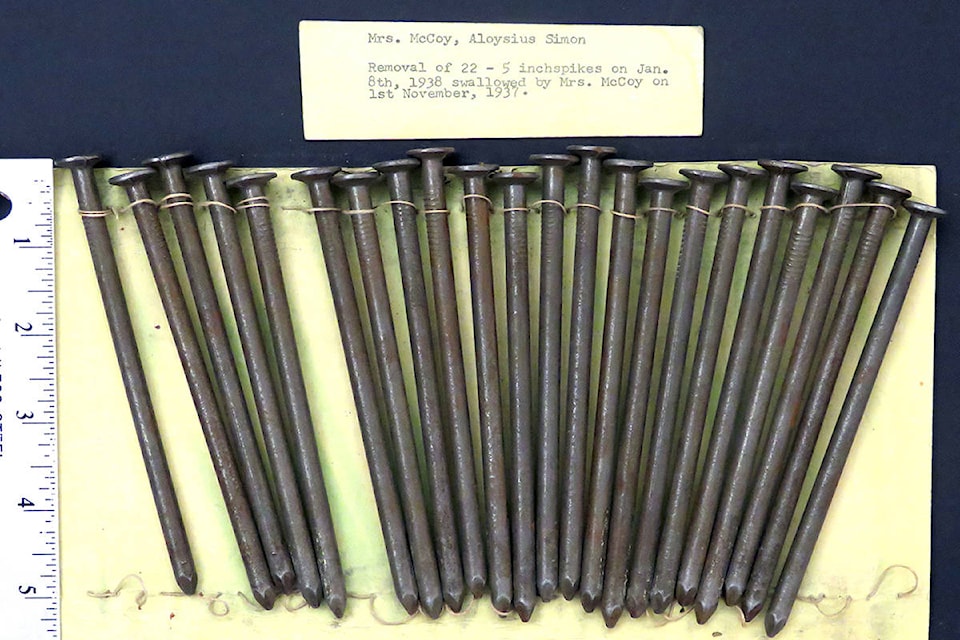Paul Rodgers
The Cranbrook History Centre Archives recently received a donation of a collection records, notes and memorabilia that belonged to Dr. Frank William Green, going back to 1901 and onwards.
The collection of memorabilia includes dozens of items and comes courtesy of Dr. Ken Brown, who works out of the F.W. Green Clinic. He had collected these items from the Green Clinic but lacked the space to store it all.
The collection includes items such as a blood-letting kit, ear-piercing kit, hand-crank drill, numerous medical textbooks, photographs, ledgers, a U.S. Navy surgery kit and letters to and from Green. Perhaps the most fascinating of the lot is the 22 five-inch nails. Not particularly intriguing on their own, but when accompanied by the story of how they came to be in Green’s possession, they are quite strange indeed.
In January, 1938 a woman named Aloysius Simon McCoy from the St. Eugene Mission wrote a letter to the hospital stating that she did not feel well, and was suffering from severe stomach pains. An ambulance collected her and Green started assessing her. He was shocked when she told him that she had, in November of the previous year, swallowed “a few spikes.”
An x-ray taken of the patient revealed that she had indeed consumed 22 five-inch nails. Green immediately operated and removed the spikes, turned black from stomach acid, and Mrs. McCoy made a full recovery.
According to a Cranbrook Herald article from that time, McCoy “apparently can give no valid reason or her unusual diet, only that it seemed a good idea to her at the time.” The article goes on to say that medical men from around Canada will be most interested in the case as will medical journals.
“Dr. Green and Cranbrook are getting publicity almost on a par with the time the circus elephants stampeded here,” the article continues. “Ripley should have the X-ray picture for his ‘Believe It or Not’ newspaper features.”
The Cranbrook History Centre’s first priority upon attaining this historic collection is to get all the materials accessioned, photographed and documented and according to David Humphrey, local historian and board member with the Centre, they are “definitely considering setting up an exhibit at some future date.”
Originally from Victoria, Green graduated from McGill University in Montreal in 1898 at the age of 22. For a short stint he worked with a busy practitioner called Dr. Jones, learning the lifestyle and working routine as he made house calls, did hospital rounds or office work.
Green soon realized this wasn’t the life for him, and so when the restless young doctor was offered the position of CPR surgeon, working to care for construction workers building the Crows Nest Railway at a salary of $100 a month, he jumped on the opportunity.
When work on the railroad dried up, Green was faced with the decision of what to do next. It was at this point when another young doctor employed as a CPR surgeon named Dr. James Horace King, who had found himself in the same situation, happened to meet Green at the Cranbrook Hotel in late 1899.
After realizing how much they had in common — both educated at McGill, former CPR surgeons with a penchant for the scenery of the Kootenays — they decided to join forces and arrange a partnership. They set up a medical practise together in the budding community of Cranbrook.
Their practise was dubbed Doctors King & Green and before long had established a favourable reputation in the area as providers of excellent medical services. Their partnership was described as a “cornerstone in local medicine” bringing new innovative methods to Cranbrook such as the first x-ray machine and the first use of automobiles with their practise.
Green died in 1953 from heart problems at the St. Eugene Hospital, which he had established and today, the F. W. Green Medical Centre and the F.W. Green Memorial Home both bear his name and continue his legacy of exceptional medical care.
